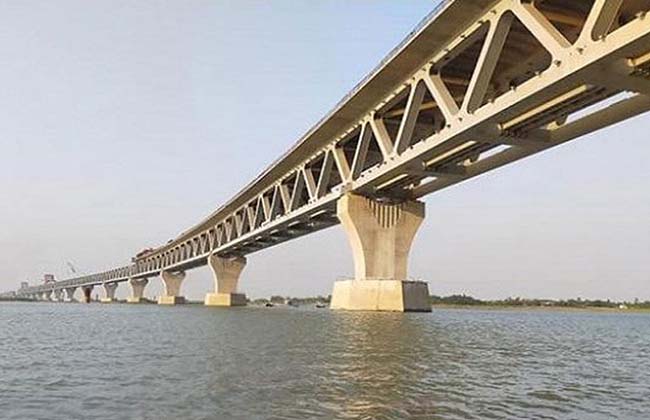
Bangladesh is set to witness a historic moment tomorrow (Saturday) with the inauguration of Padma Bridge demonstrating to the world what this country can do on its own, proving the skeptics wrong amid the World Bank’s scrapping of committed loans.
Prime Minister Sheikh Hasina, who took up the challenge to go ahead with self-financing the bridge of national pride, will formally open the road-and-rail bridge, a milestone on the connectivity front, nationally and regionally.
Since the start on December 12, 2015 the work on building the country’s longest bridge at 6.15 kilometres did not stop even for a single day despite the Covid-19 pandemic situation and Holey Artisan tragedy.
Praises keep pouring in acknowledging the prime minister’s courage, determination and political leadership amid enormous difficulties to make the bridge into a reality.
Even diplomats stationed in Dhaka spoke highly about her decision and the economic impact of the mega project.
On June 29, 2012, the World Bank posted a long statement on its website mentioning that it decided to cancel its $1.2 billion IDA credit in support of the Padma Multipurpose Bridge project, effective immediately.
The global lender claimed that it had “credible evidence” corroborated by a variety of sources which points to a high-level corruption conspiracy among Bangladeshi government officials, SNC Lavalin executives, and private individuals in connection with the Padma Multipurpose Bridge Project.
The World Bank provided information from two investigations to the PM Hasina, as well as the finance minister and the chairman of the Anti -Corruption Commission of Bangladesh (ACC) in September 2011 and April 2012.
On December 17 of the year, ACC filed a graft conspiracy case with Banani Police Station in Dhaka against Mosharraf Hossain Bhuiyan, the then Bridges Division secretary; Kazi Mohammad Ferdous, the then superintendent engineer of Bangladesh Bridge Authority, and Reaz Ahmed Zaber, the then executive engineer of the Roads and Highways Department.
The accused also included former local agent of SNC-Lavalin Mohammad Mostofa and its ex-officials Mohammad Ismail, Ramesh Shah and Kevin Wales.
The graft watchdog body in its probe report submitted to the court in September 2014 cleared all the accused in the case of the conspiracy charges, saying none had been found guilty. The ACC did not find any proof that connects former Communication Minister Syed Abul Hossain.
Mosharraf Bhuiyan, now Bangladesh ambassador to Germany, spent over 40 days in jail but he later was found innocent.
The Awami League government had taken the initiative to build the Padma Bridge in 1998 and Prime Minister Sheikh Hasina laid the foundation stone of the Padma Bridge on July 4, 2001. She inaugurated the construction of the main bridge on December 12, 2015.
Bangladesh signed an agreement to build the Padma Bridge with a Chinese firm – China Major Bridge Engineering Company on June 17, 2014.
The first span of the Padma Bridge was installed on September 30 in 2017 while the last span (41st) span was installed at 12:02pm on December 10, 2020.
Though the length of the main bridge is 6.15 km an additional four kilometres have already been built on both sides which are described as viaducts. The two-storey bridge is 22 meters wide and has four lanes.
In May, 2016 ECNEC approved the Padma Bridge Rail Link Project. On October 14, 2018, the Prime Minister unveiled the plaque of Padma Bridge at Mawa end and opened work on Padma Bridge rail link project.
Five senior engineers involved in the much talked-about Padma Bridge categorically said that the cost of its construction has been the lowest in the world in the context of the challenging realities.
A delegation led by Project Manager and Supervision Consultant of the Padma Bridge Robert John Aves apprised the prime minister of the technical issues of the project and said the bridge will last more than 100 years.
The government expects that Padma Bridge’s construction cost will be recovered in the next 35 years, according to the Bangladesh Bridge Authority (BBA).
The finance ministry provided BBA an amount of Tk 30,000 crore as credit, which will be repaid with one per cent interest rate in 35 years.
India attributed the achievement to PM Hasina’s “continuous and consistently courageous decision” while China sees the bridge as a symbol of “courage, determination and prosperity” and lauded her political courage and responsibility.
Envoys from Russia, Japan, Australia, the European Union, Saudi Arabia and Italy also highly commended Bangladesh’s efforts to build the bridge on its own but the envoys from the United States and the United Kingdom are likely to share messages ahead of the inauguration.
